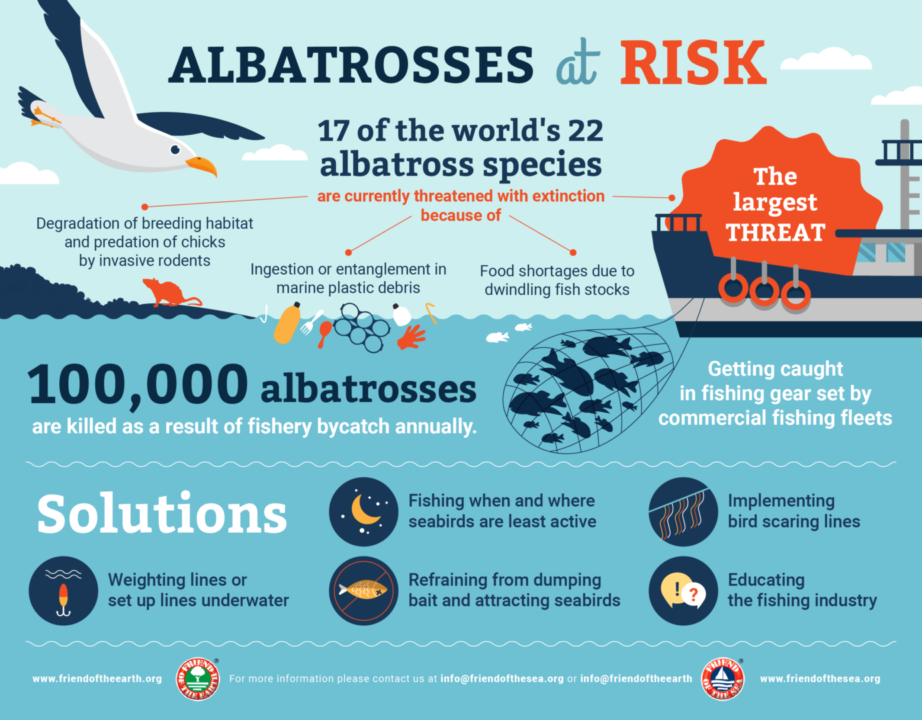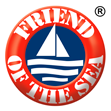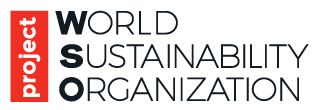Save the Albatros
The Problem
Albatrosses are iconic seabirds that spend most of their life at sea, coming ashore primarily to breed. These long-lived ocean wanderers face many threats:
- food shortages due to dwindling fish stocks
- degradation of breeding habitat
- predation of chicks by invasive rodents introduced on breeding islands
- marine plastic debris, to which they may become entangled in or ingest, mistakenly thinking it's food, ultimately resulting in them starving to death.
However, the largest threat that albatrosses face is getting caught in longline and trawlers fishing gear.
Longline fishing vessels set lines that can extend for over one hundred kilometers. Each line contains tens of thousands of baited hooks that float on the surface for a while before sinking deeper under the water, out of an albatross’s reach. Being the opportunistic scavengers they are, albatrosses gather around fishing vessels and quickly pounce on the bait before it sinks. Once an albatross grabs the bait, the bird is caught on the hook and drowns as the lines sink below the water.
Fishing trawlersalso pose a risk. Fishing crews aboard trawlers process their catch onboard so that they can catch more fish. The unwanted offal (heads and innards) are discarded overboard, attracting albatrosses who smell a free lunch from miles away. During the feeding frenzy that ensues, albatrosses can become entangled in fishing nets or they can collide with the cables used to drag the trawl nets through the water and back onboard, ending up getting caught up in the nets and dragged through the water along with the fish in the haul.

Environnemental Consequences
An estimated 100.000 albatrosses, are killed by fishing gear every year. Considering the multiple threats faced by albatrosses, and the fact that as long-living species some albatross species only breed every second year, laying just a single egg at each breeding attempt, the mortality rate is higher than the rate at which they are producing offspring. This is unsustainable and is causing the population of many albatross species to decline rapidly. We are in grave danger of losing these iconic seabirds. As a result of this continued bycatch, amongst other hazards, 17 of the world’s 22 albatross species are currently threatened with extinction – nine of which are listed as endangered or critically endangered on the IUCN Redlist of Threatenes Species.
Possible Solutions
There are several cheap, yet effective solutions that can be implemented to address the problem of seabird bycatch resulting from longlining and trawling fishing practices, including:
- Bird scaring lines — streamer lines or tori lines are bird deterrent devices consisting of ropes fitted with colorful streamers that trail behind the fishing vessel when the lines fitted with the baited hooks are set. This simple, cost-effective mitigation measure, which can be readily implemented without any modification to the fishing gear, can reduce incidental bycatch of albatrosses and other seabirds by as much as 100%.
- Setting lines when and where seabirds are least active — Fishing at times and places when and where seabirds are least active can help reduce seabird-fishery interactions, and ultimately seabird mortality resulting from these interactions. Setting lines at night, when birds are not out actively foraging for food can reduce seabird bycatch significantly. Seasonal closure of fishing grounds surrounding seabird breeding colonies could also be beneficial in this regard.
- Weighting lines or deploying lines underwater — Attaching weights to longlines to help the baited hooks sink quickly reduces the amount of time that seabirds have access to them, and therefore the likelihood of them getting caught as bycatch. Similarly, deploying the fishing lines through chutes that ensure the lines are not exposed on the surface can prevent seabirds from accessing the baited hooks before they sink underwater. Other measures, such as line shooters and bait casting machines, or deploying longlines from the side of the vessel (where there is more human activity on deck) rather than the stern (where turbulence from the propeller can hinder sinking), can also help limit seabird bycatch, especially if used in combination with other solutions such as weighting and/or bird scaring lines.
- Not attracting seabirds to fishing activities — As many seabirds are drawn to fishing vessels by the lure of discarded offal, by simply refraining from dumping bait and fish offal overboard, birds are less likely to be attracted to the vessel in the first place. By the same token, dyeing squid used as bait to make it less visible to seabirds flying overhead can help prevent attracting birds to the bait, while not impacting the catch rate of the fish species being targeted.
- Educating the fishing industry — Have effective mitigation measures to reduce seabird bycatch is one thing, but it is imperative to get the fishing industry onboard to implement these measures. To achieve this, it is essential to conduct educational campaigns that target role players in the fishing industry, encouraging fishing companies and crew to implement appropriate mitigating measures to limit bycatch of albatrosses and other seabirds. Ultimately, reducing seabird bycatch will not only improve the conservation of seabirds, but will also benefit the fishing industry, as less birds drowning on baited hooks means potentially more baited hooks available underwater to catch the intended target — fish.
WSO Activities and initiatives
The World Sustainability Organization’s Friend of the Sea project provides financial support for the Save the Albatross campaign, led by the Royal Society for the Protection of Birds (RSPB). In 2006, as part of the Save the Albatross Campaign, the RSPB together with Birdlife International launched The Albatross Task Force, made up of a team of dedicated international experts who work side-by-side with fishing crews around the world, showing them simple measures they can take to help save seabirds. They are also working closely with governments, encouraging them to better regulate the industry to protect endangered albatrosses and other seabirds from fishing activities.
The goal of the Albatross Task Force is to educate fishing vessel operators and the fishermen aboard these vessels of the conservation issues resulting from seabird bycatch, inform them of the different mitigating measures available to limit bycatch, and to help them choose the most appropriate solution to use during their fishing activities.
The initiative has been a resounding success, with bycatch of albatrosses and other seabirds at seven of the world’s top seabird bycatch hotspots being reduced significantly.
How you can help
Friend of the Sea encourages seafood companies who financially benefit from fisheries that are putting albatrosses and other seabirds at risk of extinction to engage at implementing albatross bycatch reduction methods.
Longlines and trawlers are mostly catching tuna, swordfish, cod, hake, shrimps and herrings. Check with your seafood provider and at restaurants if those species are caught by Friend of the Sea certified fleets.
You can support the Save the Albatross campaign by signing the Change.org petition, which will help Friend of the Sea convince seafood and fishing companies to make a change benefit both the fishing industry and conservation.
If we all work together, we can save the magnificent albatross from extinction.









